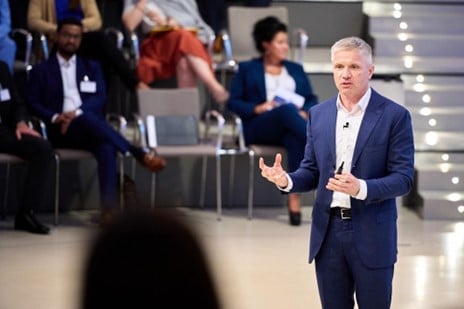"We have to ask ourselves
what a good life is."
Mr Thallinger, how important is
sustainability for Allianz?

There are surveys that give the economy poor marks for sustainability...
And how can this be achieved?
What are Allianz's priorities?
Through our global insurance and asset management business, we manage risks that affect our customers' lives and businesses, and we capitalize on opportunities that promote financial freedom, economic stability, and environmental security. From inflation to climate to cyber risks, we help people manage uncertainty and prepare for a better future.
But in places where we operate locally, we want to go one step further. We build social resilience by working toward positively influencing the current and future living conditions, employability, and the well-being of local people. We build resilience through education. Our programs and partnerships aim to help people develop the skills they need to access decent work and thrive in today's rapidly changing world of work.
Climate protection is a priority in our environmental strategy. This is Sustainable Development Goal (SDG) 13: Take action on climate change. The SDGs were adopted by the United Nations in 2015. They are excellent signposts. We can use them very well to set our priorities.
What has Allianz set itself as a target for climate protection measures?
We presented our net zero plan in 2023. In this plan, we reaffirm our commitment to the goals of limiting global warming to a maximum of 1.5 °C and reducing greenhouse gas emissions by taking concrete steps.
Our investment portfolio is to reach net zero by 2050 by reducing and offsetting emissions and we have set ourselves interim targets for this. Greenhouse gases from investments are to be reduced by 50%, emissions intensity in property and casualty insurance by 45%, and absolute emissions in motor insurance in nine key European markets — Belgium, Germany, France, the UK, Italy, the Netherlands, Austria, Switzerland, and Spain — by 30%. We also want to implement the 1.5°C target in our operations and reduce operating emissions per employee by 65% by 2030.
So we're already on the right track, aren't we?
Today's challenges are too great for one organization to solve alone. We believe that partnerships are key to bringing about the necessary changes. They can act as a catalyst and accelerate government policy and regulatory reform by highlighting issues of importance to businesses and proposing actionable plans to policy makers.
This is why we supported the creation of the UN-convened Net-Zero Asset Owner Alliance (NZAOA). Its members are asset owners from all over the world who are working on concepts for investment portfolios’ decarbonization. In our last activity report, we were able to show that the absolute emissions in the investment portfolios have fallen slightly.
In all honesty: no matter how hard we all try, do you really think that we can still avert the impending climate catastrophe?
Yes, that is a big goal. It may not seem achievable. But let's think about this step by step. Firstly, we need to reduce greenhouse gas emissions by 50% by 2030. We have the technical means, we have the financial means, we already have the first good examples of success - (see the NZAOA). It is quite feasible to achieve the first major target: 50% by 2030.
We can also see that if many countries were to finally expand the supply of energy from renewable sources as quickly and comprehensively as China, we would already be on a good path toward an energy market that can provide us with much more and cheaper energy.
To speed up expansion, we could reduce subsidies for fossil fuels and only provide support to those who really need it. The large sums saved would result in immediately available funding for more renewables. Development along the path outlined in Paris 2015 is possible.
However, we need to rethink and certainly scrutinize our values. We also need to ask ourselves what a good life is. The way we live today is not good. But we could live much better.





